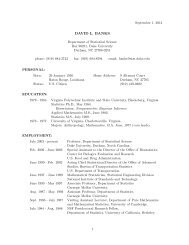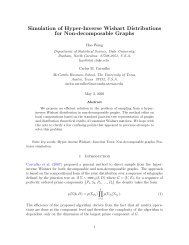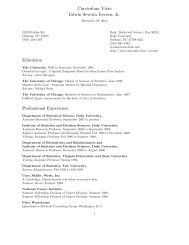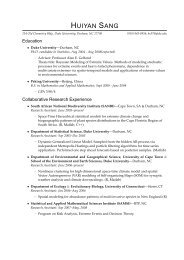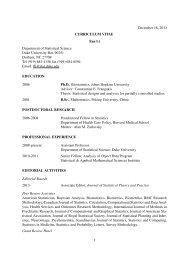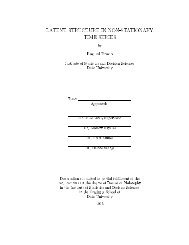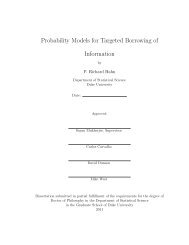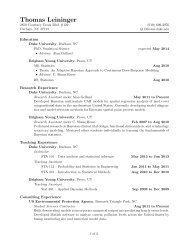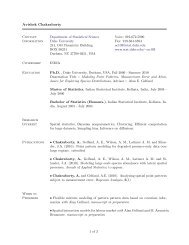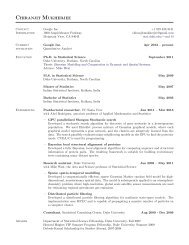Graceful Graphs
Graceful Graphs
Graceful Graphs
Create successful ePaper yourself
Turn your PDF publications into a flip-book with our unique Google optimized e-Paper software.
Kari Lock<br />
Wll Williams College<br />
Hudson River Undergraduate<br />
Mathematics Conference 2003
Dfi Definition ii<br />
Definition:Agraceful labeling is a<br />
labeling of the vertices of a graph with<br />
distinct integers from the set {0, 1, 2, ... ,<br />
q} (where q represents the number of<br />
edges) such that...<br />
if f(v) denotes the label even to vertex v, when<br />
each edge uv is given the value | f(u) – f(v) |,<br />
the edges are labeled 1, 2, ... , q
Example: K 3<br />
0<br />
2 3<br />
2 3<br />
1
Dfi Definition ii<br />
Definition: A graph G is graceful if<br />
and only if...<br />
G can be labeled gracefully.
Are The Following <strong>Graphs</strong> <strong>Graceful</strong>?<br />
• Star <strong>Graphs</strong>?<br />
• Path <strong>Graphs</strong>?<br />
•Cycle C l <strong>Graphs</strong>?<br />
• Complete <strong>Graphs</strong>?<br />
• Complete Bipartite <strong>Graphs</strong>?<br />
• Wheel <strong>Graphs</strong>?<br />
• Polyhedral <strong>Graphs</strong>?<br />
• Trees???
Star <strong>Graphs</strong><br />
1 2<br />
1 2<br />
7 3<br />
7 3<br />
0<br />
6 4<br />
5<br />
6 4<br />
5<br />
Theorem: Every star graph his graceful.
Path <strong>Graphs</strong><br />
Theorem: Every path graph his graceful.
Proof: Let G be a path graph.<br />
Path <strong>Graphs</strong><br />
• Label the first vertex 0, and label every other vertex<br />
increasing by 1 each time.<br />
• Label the second vertex q and label every other vertex<br />
decreasing by 1 each time.<br />
• There are q + 1 vertices, so the first set will label l it’s<br />
vertices with numbers from the set<br />
• {0 1 q / 2} if q is even and from the set {0 1<br />
• {0, 1, ... , q / 2} if q is even and from the set {0, 1, ... ,<br />
(q+1)/2} if q is odd. The second set will label it’s vertices<br />
with numbers from the set {(q+2)/2, ... , q} if q is even, and<br />
{(q+3)/2, ... , q} if q is odd. Thus, the vertices are labeled<br />
legally.
Path <strong>Graphs</strong><br />
• With the vertices labeled in this manner, the edges<br />
attain the values q, q-1, q-2, ... 1, in that order.<br />
•Thus, this is a graceful labeling, so G is graceful.<br />
•Therefore, all path graphs are graceful.
Path <strong>Graphs</strong><br />
3<br />
0<br />
3<br />
2<br />
1<br />
1<br />
2<br />
Theorem: Every path graph his graceful.
0<br />
Cycle <strong>Graphs</strong><br />
2 3<br />
=> NOT GRACEFUL<br />
2<br />
1<br />
3<br />
0 3 3<br />
4<br />
1<br />
4 2<br />
2<br />
Theorem:C p is graceful if and only if 4|p or 4|(p+1)
Eulerian <strong>Graphs</strong><br />
Theorem: If G is a (p, q) graceful Eulerian<br />
graph, then 4|q or 4|(q+1).
Complete <strong>Graphs</strong><br />
0 1 1<br />
0<br />
0 2 2<br />
2 3<br />
4<br />
6<br />
3<br />
5<br />
2<br />
1<br />
3<br />
6 1 5<br />
Theorem: K2, K3, K4 are the only graceful<br />
complete graphs.
More <strong>Graceful</strong> <strong>Graphs</strong><br />
‣ Complete Bipartite <strong>Graphs</strong><br />
‣ Wheel <strong>Graphs</strong><br />
‣ Polyhedral <strong>Graphs</strong><br />
‣ Peterson Graph<br />
‣ All graphs of order 4 or less<br />
‣ All graphs of order 5 except...
More <strong>Graceful</strong> <strong>Graphs</strong><br />
‣ Trees???
Tree Example<br />
Def: A tree is a connected graph with no cycles
Trees<br />
Kotzig’s Conjecture: Every nontrivial tree is graceful.<br />
This has been proved for p less than or equal<br />
to 16, and is generally assumed to be true for<br />
all trees, but no one can prove it!<br />
=> BIG QUESTION FOR GRACEFUL<br />
=> BIG QUESTION FOR GRACEFUL<br />
GRAPHS: IS EVERY TREE GRACEFUL???
Definition of <strong>Graceful</strong>???<br />
Def: A graceful labeling is a labeling of the vertices of a graph<br />
with distinct integers from the set {0, 1, 2, ... , q} (where q is<br />
the number of edges) such that when each edge uv is given the<br />
value | f(u) – f(v) |, the edges are labeled 1, 2, ... , q<br />
• integers from the set {0, 1, 2, ... , q}<br />
• integers<br />
• nonnegative integers<br />
Maybe they<br />
are all the<br />
same!!!<br />
• positive integers ???<br />
OH NO!
Conjecture 1<br />
Conjecture 1: If a graph G can be gracefully<br />
labeled by labeling the vertices from the set of<br />
integers, then G can be gracefully labeled by<br />
labeling the vertices from the set of nonnegative<br />
integers.
Conjecture 1<br />
Proof: Let G be a gracefully labeled graph, with the vertices labeled<br />
from the set of all integers.<br />
Call the smallest integer k.<br />
Subtract k from every vertex labeling.<br />
The smallest vertex labeling now is k – k = 0, so all vertices are<br />
labeled with nonnegative integers.<br />
For any two vertices u, v є V(G), the edge uv originally had the value<br />
| f(u) – f(v) |.<br />
The edge uv now has value | (f(u) – k – (f(v) – k) |<br />
= | f(u) – k – f(v) + k | = | f(u) – f(v) |.<br />
Thus, the edge values are preserved so this is still a graceful labeling.<br />
li
Theorem 1<br />
Theorem 1: If a graph G can be gracefully<br />
g p g y<br />
labeled by labeling the vertices from the set of<br />
integers, then G can be gracefully labeled by<br />
labeling the vertices from the set of nonnegative<br />
integers.
Conjecture 2<br />
Conjecture 2: If a graph G can be gracefully<br />
labeled by labeling the vertices from the set of<br />
integers, then G can be gracefully labeled by<br />
labeling the vertices from the set of positive<br />
integers.
Theorem 2<br />
Theorem 2: If a graph G can be gracefully<br />
labeled by labeling the vertices from the set of<br />
integers, then G can be gracefully labeled by<br />
labeling the vertices from the set of positive<br />
integers.
Definition i i of <strong>Graceful</strong>???<br />
Def: A graceful labeling is a labeling of the vertices of a<br />
graph with distinct integers such that when each edge uv is<br />
given the value | u-v |, the edges are labeled 0, 1, 2, ... , q<br />
(where q is the number of edges).<br />
• integers<br />
• nonnegative integers<br />
• positive integers<br />
• integers from the set {0, 1, 2, ... , q}<br />
INTERCHANGEABLE<br />
IN THE DEFINITION!
Conjecture 3<br />
Conjecture 3: If a (p,q) graph G can be<br />
gracefully labeled by labeling the vertices from<br />
the set of integers, then G can be gracefully<br />
labeled by labeling the vertices from the set<br />
{0, 1, 2, ... , q}.<br />
Unfortunately, this is still a conjecture.
Importance of Conjecture 3<br />
If Conjecture 3 is true, I will be able to prove<br />
that all trees are graceful!!!<br />
Conjecture 4: If the fact that a (p,q) graph G can<br />
be gracefully fll labeled lbldby lbli labeling the vertices from<br />
the set of integers implies that G can be gracefully<br />
labeled by labeling the vertices from the set {0, 1,<br />
2, ... , q}, then all nontrivial trees are graceful.
PROOF: (Uses Induction on q)<br />
Base Case: q = 1<br />
0 1 1<br />
Proof<br />
Induction Hypothesis: Assume every nontrivial tree with q edges is<br />
graceful.<br />
Now look at tree G with q + 1 edges.<br />
<br />
G is a tree, so has a vertex of degree 1, call it v.<br />
Now look at G – v.<br />
v only has degree 1, so deleting v is only removing one edge from G,<br />
call it edge e.<br />
So G – v has q edges.<br />
A f d 1 b i G i d<br />
A vertex of degree 1 cannot be a cut-vertex, so since G is connected<br />
(it is a tree), G – v is connected.
Proof<br />
G has no cycles (since it is a tree), so G<br />
– v has no cycles.<br />
So, G – v is a tree with q edges.<br />
So by our induction hypothesis, G – v is graceful.<br />
So the vertices of G – v can be labeled gracefully from the set {0, 1,<br />
2, ... , q}, with the edges of G – v having values 1, 2, ... , q.<br />
Now look again at G. Keep all the vertices (except v) labeled as<br />
they were in the graceful labeling of G – v.<br />
Thus the edges of G (except edge e) have values 1, 2, ... , q.<br />
We know edge e is incident id tto v, so let uv be edge e.
Proof<br />
u is already labeled some integer from the set {0, 1, 2, ... , q}, call<br />
the integer u is labeled k.<br />
Label vertex v with k + q + 1.<br />
This is legal since all the other vertices of G are labeled from the<br />
set {0, 1, 2, ... , q} and k + q + 1 > q, so no other vertex has this<br />
label.<br />
Then edge e has value | (k + q + 1) – k|= |q+1|= | q+1.<br />
Therefore, the edges of G have the values 1, 2, ... , q, q + 1.<br />
So the vertices of G are labeled ed with distinct integers, and the edges<br />
have values 1, 2, ... , q + 1.<br />
Thus, G is graceful.
Theorem 4<br />
Theorem 4: If the fact that a (p,q) graph G can be<br />
gracefully labeled by labeling the vertices from<br />
the set of integers implies that G can be gracefully<br />
labeled by labeling the vertices from the set {0, 1,<br />
2, ... , q}, then all nontrivial trees are graceful.
Anyone Interested???<br />
Kari.F.Lock@williams.edu
References<br />
Behzad, Mehdi, Chartrand, Gary, & Lesniak-Foster, Linda. <strong>Graphs</strong> &<br />
Digraphs. Wadsworth: Belmont, CA. 1979. pg 51.<br />
Chartrand, Gary & Lesniak, Linda. <strong>Graphs</strong> & Digraphs; second edition.<br />
Wadsworth, Inc.: Belmont, CA. 1986. pgs 76-77.<br />
Chartrand, G. & Lesniak, L. <strong>Graphs</strong> & Digraphs; third edition. Chapman<br />
& Hall: London, UK. 1996. pgs 281-301.<br />
Kevin Gong. http://kevingong.com/Math/<strong>Graceful</strong><strong>Graphs</strong>.html. 10/30/02.<br />
Weisstein, Eric W.<br />
http://hades.ph.tn.tudelft.nl/Internal/PHServices/Documentation/M<br />
athWorld/math/math/g/g226.htm. 10/30/02.<br />
West, Douglas B. Introduction to Graph Theory. Prentice Hall: Upper<br />
Saddle River, NJ. 1996. pgs 69-73.<br />
West, Douglas B. Introduction to Graph Theory; 2 nd edition. Prentice Hall:<br />
Upper Saddle River, NJ. 2001. pgs 89-94.






